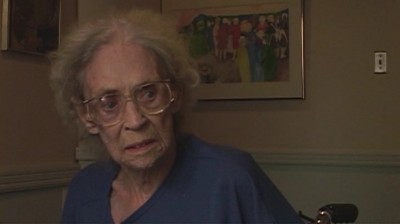**** (Masterpiece)

Allan King was one of Canada’s, and the world’s, great vérité documentary filmmakers. He died of cancer in 2009. Mr. King’s actuality dramas were fly-on-the-wall documentaries examining relevant issues through astute portraits of raw psychology. Mr. King was a strong advocate for a Canadian national cinema and his filmography includes critically acclaimed National Film Board documentaries and Canadian fiction films: Skid Row (1956), Rickshaw (1960), A Married Couple (1969), Warrendale (1966), Who Has Seen The Wind (1977), and Whose In Charge (1983). Jean Renoir described him in a letter to Allan King’s publicist as “a great artist” after seeing Warrendale.
In Dying at Grace (Rated #7 in the Macleans top ten Canadian films of the 00’s list), Allan King and his director of photography Peter Walker unobtrusively record the process of dying at the Salvation Army’s Toronto Grace Health Center. Over the course of one winter the film follows five terminally ill patients in its palliative care ward, which is a treatment that concentrates on the reduction of disease severity and suffering. The patients decide what kind of treatment is right for them, which includes declining life support, to smoke cigarettes etc. It is a relevant Canadian subject as the publicly funded health care system is an integral quality of Canada’s political and social infrastructure.
The patients in Dying at Grace are Joyce, Eda, Carmella, Rick, and Lloyd. They all differ in gender, age, ethnicity, sexual orientation, profession, and outlook. The patient’s presence represents lived experiences. The Italian-Canadian Carmella in her home country picked tomatoes to support her family, Lloyd is a minister and his partner Norm desperately hangs bedside with him, Joyce’s life since childhood has been filled with death, Rick used to be homeless drug addict and now has fits of paranoia, while Eda is perseverant as her health fluctuates and her closes relationship is with her step-brother. As some film-critics have noted, Dying at Grace with its treatment of the elderly completes Allan King’s trilogy of man, witch began with childhood in Warrendale and continued onwards to adulthood in A Married Couple.
The diagnosed terminally ill patients go through what psychiatrist Elizabeth Kübler-Ross describes as the five stage model to deal with grief. The stages are denial, anger, bargaining, depression, and acceptance. The patient’s experiences and feelings are shown through conversations with the staff, revealing their subjective descriptions of their phenomenology, while the medical staff objectively describes their behavior in an overheard audio recording. The staff also is perceived to be in pain, as the young nurses look worn-down due to the intensity of their surroundings. The older staff seems both more resilient and ambivalent as they provide authentic support and contact comfort, however desperate the patient’s situation.
The cinematography and dialogue at time adds depth and irony to the people and surroundings. Eda is offered a one-year gym membership, though she will probably not live for that long. Watches and calendars are constant reminders of the impending cessation of life. The walls of the rooms and hospital are filled with images of past lovers and family, tropical sunsets, and television shows filled with “healthy normal people”. There is an apt visual metaphor of Joyce sitting in the shadows, this is a documentary of the people who are brushed over, who are soon forgotten, and whose in place in society have been pushed to the margins - similarly to collaborators in the films of the Montreal social reality documentarist Donigan Cumming.
Though the patient’s condition is fatal their situation is not all that bad. It is a miracle that they are there in a hospital setting. One can just imagine all the people who are not afforded this service. The scenes of the patients enjoying simple pleasures like reading, listening to portable music player, being with friends, praying, and recollecting their life experiences remind the viewer how similar we are to these people and how this transition is an inevitable meta-physical reality. The afterlife idea is accentuated by the morning-after-death establishing shots of the Toronto skyline with the CN has orange sunlight seeping down onto the city, increasing the intensity after each death.
Dying at Grace illustrates the multifaceted issue of death – a similar concept explored in Ottawa filmmaker Frank Cole’s A Life (1986) – as an inescapable haunting experience. In the exhaustive last scene, once all of the other patient have died, there is a close-up of Eda’s shriveling face on her bed sleeping. Her respiratory physiology is slowly deteriorating and with each breath and neck clench there are longer pauses, until they stop.-David Davidson
(Canadian Film Institute, Library and Archives Canada, 395 Wellington Street, 14/03, 7PM)
No comments:
Post a Comment